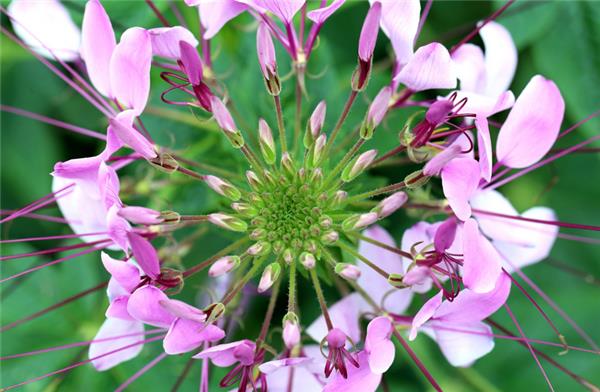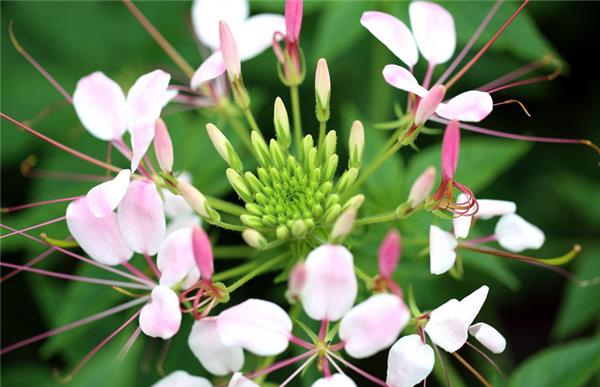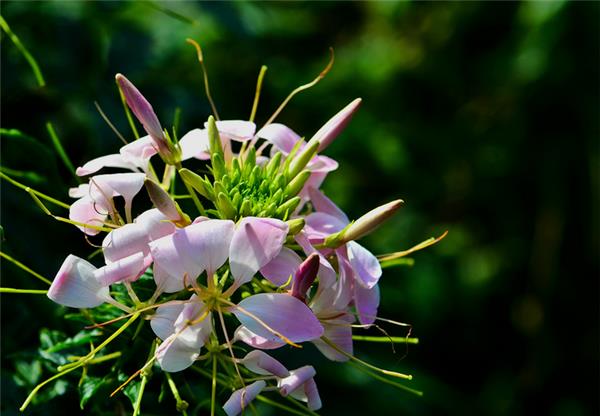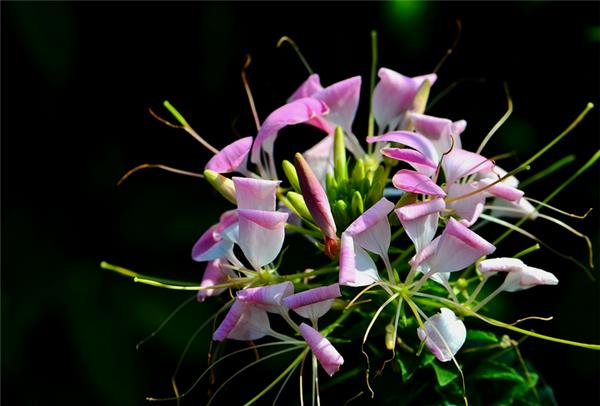Introduction and cultivation of Drunken Butterfly Flower
Drunken butterfly flower is a kind of ornamental plant, drunken butterfly flower color is brilliant, graceful, pink at first, then pink, and then purplish red, it is the favorite of many flower growers. Next, let's take a look at the relevant knowledge of drunken butterfly flower.

I. introduction of drunken butterfly flowers
The pedicel of drunken butterfly flower is long and sturdy, the raceme forms a luxuriant flower ball, the flower shape is beautiful and chic, the petals are reunited like a fan, the stamens are protruding like claws, the shape is like butterfly dancing, the flower color is delicate and beautiful, it is pink at the beginning, it turns pink for the second time, and then it becomes purplish red, one flower is multicolor and has nectaries, which often intoxicate the flying butterfly, hence the name. The long stamens protruding beyond the Corolla, shaped like spiders and dragon whiskers, are quite interesting. When the drunken butterfly blossoms, the petals open slowly, and the long claws bend to pop out of the flowers, just like a movie shot. The ground can be planted on the wall of the courtyard and under the trees. Potted plants can be placed on the desk in front of the window, and the plant shape should be controlled so as not to grow too high.

Second, the morphological characteristics of drunken butterfly.
Annual strong herbs, 1-1.5 m tall, the whole plant is covered with sticky glandular hairs, has a special smell, stipule spines, thorns up to 4 mm long, sharp, curved. Leaves palmately compound with 5-7 leaflets, leaflet herbaceous, elliptic-lanceolate or oblanceolate, central leaflet magnificent, 6-8 cm long, 1.5-2.5 mm wide, outermost smallest, ca. 2 cm long, ca. 5 mm wide, base perpendicular, narrowly extended into petiolule, slightly webbed at connection with petiole, tip attenuate or acute, with short tip, both surfaces hairy, abaxial midrib sometimes prickly on lateral veins 10-15 pairs of lateral veins Petiole 2-8 cm long, often with yellowish prickles. Racemes to 40 cm long, densely covered with sticky glandular hairs; bracts simple 1, leaflike, ovate-oblong, 5-20 mm long, sessile or subsessile, base ±cordate; buds cylindrical, ca. 2.5 cm long, 4 mm in diam., glabrous; pedicels 2-3 m long, covered with short glandular hairs, solitary in bract axils; sepals 4, 6 mm long, oblong-elliptic, apex acuminate, outer glandular hairy Petals pink, rarely white, imbricate in bud, glabrous, claw 5-12 mm long, limb Obovate spatulate, 10-15 mm long, 4-6 mm wide, apex rounded, base attenuate; stamens 6, filaments 3.5-4 mm long, anthers linear, 7-8 mm long; pistil stalk 1-3 mm long; pistil stalk 4 mm long, slightly growing in fruit. Ovary linear columnar, 3-4 mm long, glabrous; few styles absent, stigma capitate. Fruit cylindrical, 5.5-6.5 cm long, middle diameter about 4 mm, both ends obtuse, the surface is nearly flat or emblem is beaded, with fine and dense and not very clear veins. Seeds ca. 2 mm in diam., surface nearly smooth or verrucose, without aril. Flowering in early summer, fruiting in late summer and early autumn.

Third, the cultivation techniques of drunken butterfly.
Seedlings should be time seedlings, transplanted with 2-3 true leaves, planted or potted in June, taproot plants, small whisker roots, difficult to recover after transplantation, usually direct seeded in the open field in spring, or when the seedlings grow to about 5 meters high, transplanted in fertile soil. Generally, there is no need for topdressing, fertilizing once every semimonthly during the growth period, and water and fertilizer should be controlled during the growth period to prevent the overgrowth of plants and affect flowering. The flower bud formation and flowering stage can be prolonged by applying topdressing for 2 or 3 times. It is better to water at ordinary times in order to keep half of the soil moisture, and to water frequently in times of drought.
When flowering, a pillar should be set up to prevent lodging. If no seed is left, the residual flowers should be cut off in time after fade, so as to reduce the nutrient consumption and prolong the flowering period. The whole plant has sticky hair and less water consumption. except for more water in flowering stage, it can be irrigated or less watered at seedling stage, which is easier to manage. Watering at least once a day in summer, in case of high temperature and drought, can be moved to a cool place, wait for the basin soil to cool and then rewater. The amount of water can be reduced in autumn and winter, and then watered when the surface of the basin soil is dry. Light temperature drunken butterfly flower likes high temperature and heat resistance, the most suitable growth temperature is 20 ℃ to 32 ℃, it likes light, although it can grow under semi-shade conditions, but in order to dwarf it, it is better to see more direct light as much as possible, preferably more than 4 hours a day. When planting flower beds, the residual flowers should be picked in time so that they do not bear seeds in order to prolong the flowering period.

For potted plants, the top buds were removed at the seedling stage and nitrogen fertilizer was controlled to dwarf the plants. For cut flowers, the plants can be slightly denser and lateral buds can be removed to promote the development of terminal bud inflorescences. If you want to make the drunken butterfly blossom in the Spring Festival, you can plant it in autumn and move into the sunny place indoors before winter. the indoor temperature should be maintained at about 20 ℃, the potted soil should be kept slightly moist, and the thin compound liquid fertilizer should be applied 2 or 3 times during the bud period, which can bloom during the Spring Festival.
The above is the relevant knowledge of drunken butterfly, I hope I can help you.
Always keep the basin soil slightly moist, apply 2 or 3 thin compound liquid fertilizers during the bud period, and blossom during the Spring Festival.
The above is the relevant knowledge of drunken butterfly, I hope I can help you.
Related
- Wuhan Hospital Iron Tree Blooming Result Was Instantly Frightened by the Gardener Master
- Which variety of camellia is the most fragrant and best? Which one do you like best?
- What is the small blue coat, the breeding methods and matters needing attention of the succulent plant
- Dormancy time and maintenance management of succulent plants during dormancy
- Minas succulent how to raise, Minas succulent plant pictures
- What are the varieties of winter succulent plants
- How to raise succulent plants in twelve rolls? let's take a look at some experience of breeding twelve rolls.
- Attention should be paid to water control for succulent plants during dormant period (winter and summer)
- Watering experience of twelve rolls of succulent plants
- Techniques for fertilizing succulent plants. An article will let you know how to fertilize succulent plants.



